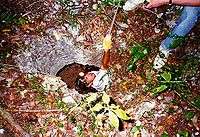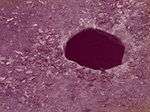Chultun
A chultun (plural: chultunob' or chultuns) is a bottle-shaped underground storage chamber built by the pre-Columbian Maya in southern Mesoamerica. Their entrances were surrounded by plastered aprons which guided rainwater into them during the rainy seasons. Most of these archaeological features likely functioned as cisterns for potable water.


Chultunob' were typically constructed in locations where naturally occurring cenotes[1] were absent (such as the Puuc hills, which sit hundreds of feet above the Yucatán Peninsula aquifer). While many were constructed to collect water, not all may have served that purpose. Some chultuns may have been used for storage of perishable comestibles or for the fermentation of alcoholic beverages. Experimental research conducted in the 1960s by Mayanist Dennis E. Puleston demonstrated that chultuns around Tikal were particularly effective for long-term storage of ramon nuts (Brosimum alicastrum).[2]
After a chultun ended its usefulness, many were used for discarding refuse or for human burials. This makes chultunob' an excellent source of information on both the life and death of ancient settlements of the Prehispanic Maya.
See also
Notes
- Sinkholes formed in limestone karst.
- Stavrakis-Puleston, Olga (2015). Settlement and Subsistence in Tikal, The assembled work of Dennis E. Puleston (Field research 1961-1972). Oxford: British Archaeological Reports. ISBN 9781407314198.
External links

- Mesoamerican Photo Archives: click on "chultun" for more info